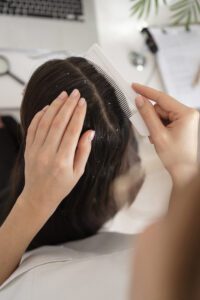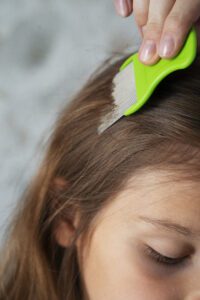Table of Contents
Introduction
Understanding Head Lice
Symptoms and Early Signs
How Do Lice Spread?
Why Lice Are Hard to Eliminate
Permanent Solutions to Remove Lice
a. Over-the-Counter (OTC) Treatments
b. Prescription Treatments
c. Natural Remedies
d. Professional Lice Removal Services
Daily Habits to Prevent Reinfestation
Lice Myths and Facts
FAQs on Head Lice Removal
Final Thoughts
1. Introduction
Head lice can be a nightmare for parents, children, and even adults. These tiny parasites live on the scalp and feed on human blood, causing discomfort, itching, and embarrassment. While not dangerous, lice can be stubborn to get rid of and often return even after treatment. Fortunately, with the right approach, you can Permanently Remove Lice from Hair and prevent future infestations.
This guide covers effective, evidence-based methods that work for both adults and children. Whether you’re trying a home remedy or seeking medical solutions, this article will help you understand how to get rid of lice permanently.

Source – https://in.pinterest.com/pin/861735709967577443/
2. Understanding Head Lice
Head lice (Pediculus humanus capitis) are tiny, wingless insects that live on the human scalp. Adult lice are about the size of a sesame seed and lay eggs (nits) close to the scalp.
-
Nits (eggs): Small white or yellowish eggs glued to hair shafts.
-
Nymphs: Immature lice that hatch from nits.
-
Adults: Fully developed lice that reproduce quickly.
Lice do not fly or jump. They crawl from person to person via direct contact or by sharing combs, hats, or bedding.

Source – https://in.pinterest.com/pin/451978512624477168/
3. Symptoms and Early Signs
Recognizing lice early increases your chances of eliminating them quickly.
Common symptoms include:
-
Intense itching on the scalp
-
Tickling or crawling sensation in hair
-
Red bumps or sores on the neck or scalp
-
Presence of lice or nits on hair shafts
Use a fine-tooth comb to check for lice, especially near the nape of the neck and behind the ears.
Read my Latest Blog – https://eternallyglowing.com/how-often-should-you-wash-your-hair
4. How Do Lice Spread?
Understanding how lice spread helps in preventing and stopping reinfestation.
Common transmission routes:
-
Head-to-head contact (most common)
-
Sharing combs, brushes, hair accessories
-
Using infested hats, scarves, or pillows
-
Group settings like schools, sleepovers, or daycare
Lice cannot survive more than 1–2 days without a human host, but eggs can remain viable for longer.
Read it – https://eternallyglowing.com/effective-low-porosity-hair-routine
5. Why Lice Are Hard to Eliminate
Lice are resilient pests. Here’s why removing them permanently can be challenging:
-
Nits are glued to hair and hard to remove manually.
-
Lice can become resistant to certain treatments.
-
Reinfection from untreated family members is common.
-
Many treatments only kill live lice, not eggs.
That’s why a comprehensive approach is essential for permanent removal.
6. Permanent Solutions to Remove Lice

a. Over-the-Counter (OTC) Treatments
Many OTC shampoos and lotions are available that kill lice on contact.
Popular options include:
-
Permethrin (Nix): Kills live lice, but may not kill nits. A second treatment may be needed.
-
Pyrethrin-based products (Rid): Natural insecticides derived from chrysanthemums.
Pros:
-
Widely available
-
Easy to use
Cons:
-
Some lice have developed resistance
-
Might not kill eggs
Instructions:
-
Follow product directions carefully
-
Repeat in 7–10 days if needed
-
Comb out dead lice and nits with a fine-tooth lice comb
b. Prescription Treatments
If OTC options fail, consult a doctor for stronger treatments.
Common prescription options:
-
Malathion (Ovide): Kills lice and some nits. Flammable, so use with caution.
-
Spinosad (Natroba): Kills lice and eggs. Usually effective in one treatment.
-
Ivermectin (Sklice): Paralyzes and kills lice. Does not require nit combing.
Advantages:
-
More effective against resistant lice
-
Often needs only one application
Precautions:
-
Use only as prescribed
-
Avoid contact with eyes and open wounds
c. Natural Remedies
Some prefer chemical-free methods. While less studied, several natural remedies show promise.
Popular home remedies include:
-
Wet Combing:
-
Apply conditioner to damp hair
-
Use a fine-tooth comb to remove lice and eggs
-
Repeat every 2–3 days for 2 weeks
-
-
Tea Tree Oil:
-
Mix with carrier oil and apply to scalp
-
Has natural insecticidal properties
-
-
Coconut Oil & Apple Cider Vinegar:
-
Vinegar loosens nits, oil suffocates lice
-
Apply vinegar first, then oil, and cover overnight
-
-
Neem Oil:
-
Contains azadirachtin, which disrupts lice life cycle
-
Important Note: Natural remedies may require repeated application and diligent combing.
d. Professional Lice Removal Services

Lice clinics and mobile removal services are available in many cities.
Benefits include:
-
Expert treatment with medical-grade tools
-
Heat-based devices to kill lice and eggs
-
Guaranteed results in some cases
Cost: Can be expensive but offers peace of mind
Recommended for:
-
Persistent infestations
-
Large families or multiple affected individuals
7. Daily Habits to Prevent Reinfestation
After treatment, prevention is crucial to stop lice from returning.
Preventive measures:
-
Wash bedding, clothing, and towels in hot water
-
Vacuum furniture and car seats
-
Seal unwashable items in a plastic bag for 2 weeks
-
Avoid sharing personal items (combs, hats, pillows)
-
Check and treat all family members if needed
Hair care tips:
-
Keep long hair tied or braided in crowded spaces
-
Use tea tree oil spray as a natural repellent
-
Regularly check children’s hair, especially during outbreaks
8. Lice Myths and Facts
Myth 1: Only dirty people get lice
Fact: Lice prefer clean hair as it’s easier to cling to.
Myth 2: Lice can jump or fly
Fact: Lice crawl. They do not jump or fly.
Myth 3: Pets spread lice
Fact: Lice are species-specific and cannot survive on animals.
Myth 4: You only need to treat the person once
Fact: Nits can hatch days later. Follow-up treatment is often necessary.
9. FAQs on Head Lice Removal
Q1: How long do lice live?
A: Adult lice live about 30 days on a host. Off the scalp, they die in 1–2 days.
Q2: Can lice survive hair dye?
A: Hair dye may kill some lice, but it’s not a reliable treatment.
Q3: How do I check for lice at home?
A: Use a bright light and a lice comb. Part the hair and check near the scalp, especially behind ears and neck.
Q4: Are lice dangerous?
A: Lice do not transmit disease but can cause discomfort, infection from scratching, and social stigma.
Q5: What should I do if treatments don’t work?
A: Consult a doctor for prescription medications or seek professional removal services.
10. Final Thoughts
Dealing with head lice is stressful, but it doesn’t have to be a recurring problem. With the right combination of treatment and prevention, you can permanently remove lice from hair and keep your family lice-free.
Remember:
-
Be patient and thorough
-
Follow instructions carefully
-
Treat everyone in close contact
-
Maintain good hygiene and regular checks
If you’re overwhelmed, don’t hesitate to seek professional help. With consistent care, lice can be completely eliminated.

